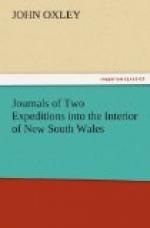June 26.—The country this day was as various as can be imagined; low but not level; in some places covered with the acacia pendula, chenopodeae, and polygonum juncium; in others, with good gum and box trees. The whole, with few exceptions, appeared liable to flood. Four or five miles back the country imperceptibly rises, and is free from river floods; but the hollows, proceeding from the inequalities of its surface, are in rainy seasons the reservoirs of the land floods. The whole country was now perfectly dry, and must have been so for a long period: it would indeed have been impossible, had the season been wet, to have kept company with the boats. The river itself continues undiminished, and is a fine stream, with nothing to impede the navigation; its windings, however, are very considerable. The banks appear lower by nearly three feet than yesterday: there are still no marks of flood rising upon the land above a foot on either side: the depth of the stream is from twenty to twenty-four feet, breadth from sixty to one hundred and sixty, and its current is about a mile and a half per hour. The river has fallen yesterday and to-day nearly eighteen inches.
June 27.—The river continues to fall. We had gone about five miles through a country as low and brushy as usual, when we were agreeably surprised with the view of a small hill about a mile to the eastward: we hastened to it, in hopes that we should find that the country rose to the north-east; we however saw nothing but another hill still higher, about three miles to the north-north-west, in the direction of the river. The hill, or rather rock, we had just quitted, was about a quarter of a mile long by half a quarter broad, and about seventy feet high; it was nothing but granite, having the sides and summit covered with broken pieces of a fine and very compact species of the same mineral. We named it Welcome Rock; for any thing like an eminence was grateful to our sight. From the summit of the hill seen to the north-north-west our view was very extensive; but nothing indicated either a speedy change of country or a termination of the river. To the westward, the land was a perfect level, with clear spaces or marshes interspersed amidst the boundless desert of wood. To the east, a most stupendous range of mountains, lifting their blue heads above the horizon, bounded the view in that direction, and were distant at least seventy miles, the country appearing a perfect plain between us and them. From north-west to north-east nothing interrupted the horizontal view, except a hill similar to the one we were on, about five miles distant to the north-north-west. Extended as was our prospect, it did not afford much room for satisfactory anticipation; and there was nothing that gave us reason to believe that any stream, either from the east or west, joined the river for the next forty miles at least. The hill from which this view was taken was named Mount Harris, after my friend, who accompanied




